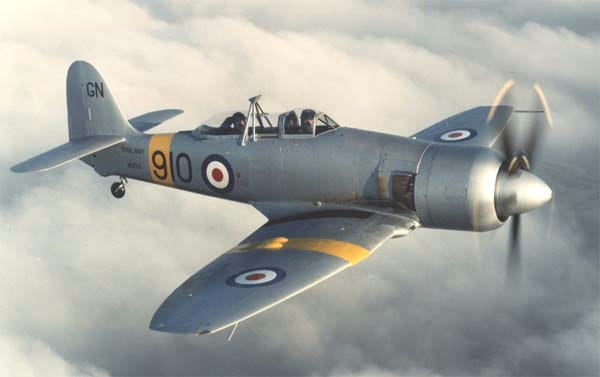Hawker Sea Fury History
The Hawker Sea Fury was the Fleet Air Arm’s ultimate piston-powered aircraft, probably the best of its class in the world. Origins of the mighty Hawker Sea Fury trace back to June 1942, when a German Focke-Wulf Fw 190 fighter mistakenly landed in England. Heretofore, radial engines had been dismissed as inferior to more complicated in-line types, but the streamlining and efficiency of the German craft surprised the British. Accordingly, the Air Ministry issued several specifications in 1943 for a lightened Hawker Tempest to equip both the Royal Air Force and Fleet Air Arm. Hawker was to design and develop the land-based version, and Boulton Paul to undertake the conversion of the naval aircraft.
Sir Sydney Camm then developed an entirely new monocoque fuselage, fitted it to Tempest wings, and mounted a powerful Bristol Centaurus radial engine. The resulting craft was called the Fury, a compact, low-wing fighter of great speed and strength. By December 1943, six prototypes had been ordered: one was to be powered by a Bristol Centaurus XII, two with the Centaurus XXII, and two with the Rolls Royce Griffon; the sixth was to be a test airframe. The first to fly was the Centaurus XXII-powered aircraft, which made its maiden flight on 1 September 1944, followed by the Griffon 85-engined second prototype on 27 November; the latter re-engined with a Napier Sabre VII.
Although production contracts had been placed in April 1944 for 200 Hawker Sea Fury aircraft for the Royal Air Force, and a similar number for the Fleet Air Arm, including 100 to be built by Boulton Paul, the RAF order was cancelled at the war’s end. Development of the Sea Fury continued, however, the first prototype having flown on 21 February 1945 powered by a Centaurus XII. This aircraft was fitted with an arrester hook, but retained non-folding wings; the first fully-navalised aircraft was the Centaurus XV-powered second prototype, which flew on 12 October.
The Boulton Paul contract had been cancelled in January 1945, and of the 100 Hawker Sea Fury aircraft that remained on order the first 50 were completed as Mk X fighters. The first of these was flown on 7 September 1946, and the third undertook trials aboard HMS Victorious during the winter of 1946-7, prior to the type entering service with Nos. 778, 802, 803, 805 and 807 Squadrons.
Commencing in 1950, several squadrons of Hawker Sea Fury fighters participated in the Korean War (1950–1953). They carried prodigious ordnance loads, made excellent bombing platforms, and extensively flew interdiction strikes against communist supply lines. Sea Furies also destroyed more communist aircraft than any other non-American type and demonstrated their prowess by shooting down at least two MiG 15 jet fighters.










